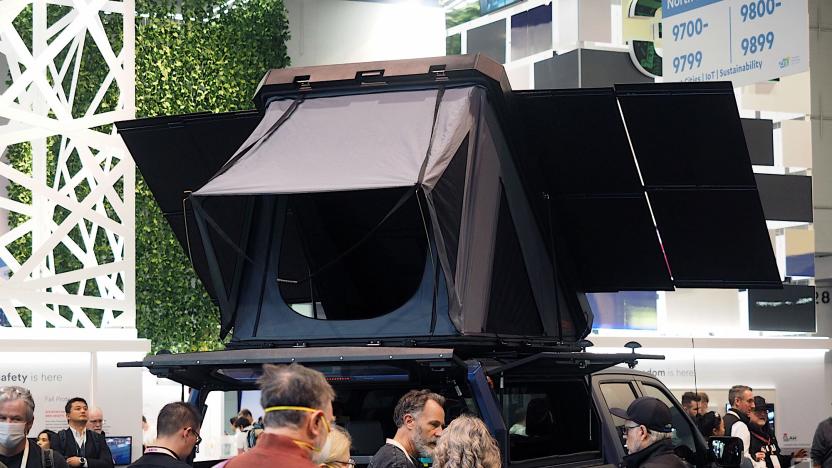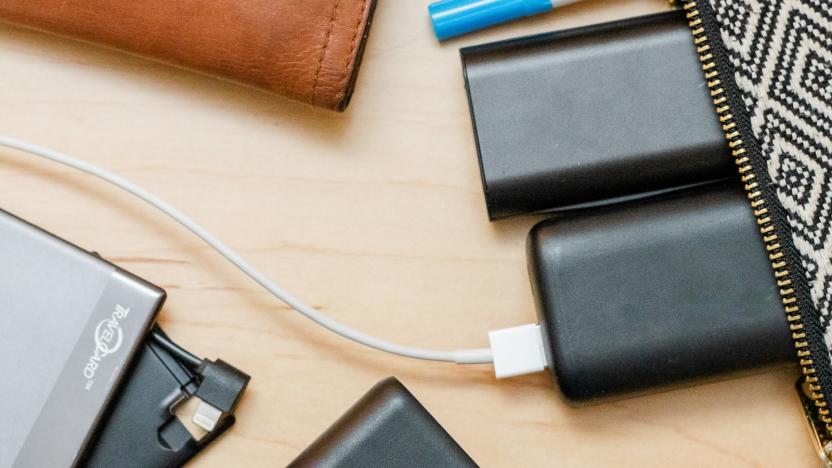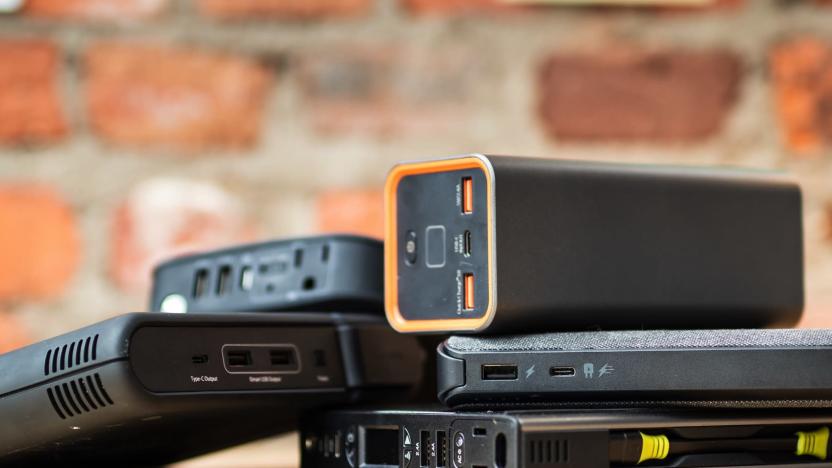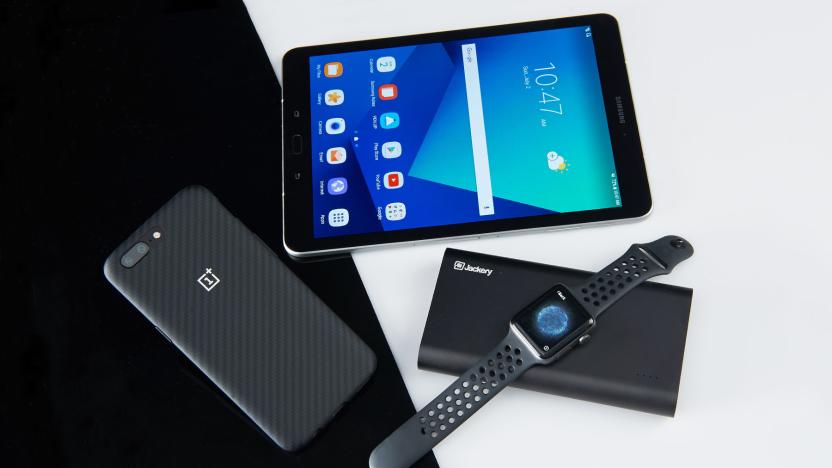Jackery
Latest

Jackery shows off a rooftop solar tent at CES that makes overlanding more environmentally friendly
It's an all-in-one solar station for your truck roof.

The best USB power banks for phones and tablets
By Sarah Witman This post was done in partnership with Wirecutter. When readers choose to buy Wirecutter's independently chosen editorial picks, Wirecutter and Engadget may earn affiliate commission. Read the full guide to USB power banks for phones and tablets. USB power banks offer peace of mind when your battery is dead or close to dying but you don't have access to a wall outlet. After nine hours of research and 30 hours of testing, we've found the best USB power banks to meet a wide range of needs—whether you're looking for a backup boost of power or something that will keep your phone or tablet fully charged for days at a time. The TravelCard Charger is the best option for someone who wants an emergency boost of power that's always on hand. It has the lowest capacity of any power bank we tested—it can charge most phones to only around 30 to 50 percent from empty—but it's unmatched in terms of weight (exactly 2 ounces) and size. It's bigger and thicker than the average credit card but not by much; it easily fits in a wallet or pocket. It has a built-in USB-A cable to charge it up and a built-in output cable (either Lightning, Micro-USB, or USB-C, depending on which version you need) to top off your phone or another handheld device with a little boost of power. The Jackery Bolt has been our favorite power bank to carry every day for several years running for a reason. It's as powerful as it is portable, fitting a high capacity—nearly two full charges for the latest smartphones—into a small package. You can also easily slip it into a small purse or most pants pockets—except maybe your tightest-fitting jeans. The two built-in output cables (Micro-USB and Lightning) mean you don't need to carry a cable to charge most devices, but it also has a fast-charging USB-A output port if you want to use your own longer cable. It comes with a built-in flashlight, which is a neat bonus. The Anker PowerCore 10000 PD lacks the built-in cables that set the Jackery and TravelCard models apart, but its capacity (10,000 mAh—enough to fully charge an iPhone XS more than three times) is a lot higher. Plus, in addition to a USB-A output port, it has a USB-C Power Delivery (PD) port that enables charging (both input and output) up to 18 watts—nearly twice as fast as most power banks we've found with built-in cables. This means less time waiting around for your phone, tablet, or other device (and the power bank itself) to charge. It's about the same size and weight (6.9 ounces) as the Jackery, and its rounded edges make it even easier to slide into a pocket or pouch. The Anker PowerCore Fusion 5000 is handy if you want a single, reliable device that you can plug in the wall to charge your devices overnight and then pack up and carry with you during the day. Its 5,000 mAh capacity is similar to that of the Jackery Bolt, enabling you to fully charge a phone like the iPhone XS more than once, and its two USB-A ports offer fairly fast charging for two devices at a time. We also appreciate that it offers Micro-USB input in addition to a fold-out AC plug—an important feature that other two-in-one models we considered lack. If you want a power bank that doubles as a wall charger, this is the best option we've found.

The best portable laptop charger
By Sarah Witman This post was done in partnership with Wirecutter. When readers choose to buy Wirecutter's independently chosen editorial picks, Wirecutter and Engadget may earn affiliate commission. Read the full portable laptop charger guide here. We spent 15 hours researching and 41 hours testing five top portable laptop chargers, and we found that the Mophie Powerstation AC is the best option if you want the ability to charge your computer and smaller devices while traveling, in an emergency, or whenever power outlets are out of reach. It can power laptops as robust as the 15-inch MacBook Pro, it's compact and lightweight, and it charges via USB-C—an increasingly ubiquitous standard. Mophie's charger is the one we'd buy ourselves. It's the smallest laptop charger we tested and one of the lightest. But it still performed well in our testing with more than 100 W of power output and enough capacity to bring a dead MacBook Air up to 81 percent charged, even during heavy use. It also has the best look and feel of any we tried—we really like how its slim, portable design and professional-looking fabric exterior is complemented by well-placed ports and a magnetic rubber flap protecting the AC output port. Plus, it's made by a company we trust, and its 24-month warranty is as good as any we found.

The best smartphones and mobile gear for students
Some of us here at Engadget can remember a time when cellphones on college campuses were strictly "for emergencies" (read: calls home to Mom and Dad). By now, of course, things have changed: Our handsets come with us everywhere, and most of us don't have to worry about pissing off our parents by exceeding our minutes allotment. We imagine many of today's college freshmen already have phones, but for those of you who've earned an upgrade, we crammed five into our back-to-school guide, including some budget options. Not in the market yet for a new phone? You might still want an external battery pack, a fast microSDXC card or, heaven forbid, a "selfie case," which is definitely a thing.

Free Jackery app provides iPhone battery insights
Jackery is best-known as a manufacturer of external battery packs; we've reviewed several of their products in the past, the Jackery Giant 10,400 mAh battery pack and the Jackery Leaf battery case for iPhone 5 and 5s. Now the company wants iPhone users to gain more insight into exactly how the batteries in their devices are using that precious power, and they've introduced a free Jackery app today that does just that. There are four main features in the app: It monitors your battery consumption day and night, 24/7 It accurately estimates just how much time you have left on your device It notifies you when it might be a good time to plug your iPhone into a wall socket or a Jackery (or other) battery pack It's full of hints on how to maintain your battery for extended usage and longer life Upon launching the app, you're immediately greeted with the Monitor screen. It shows you the remaining percentage of energy stored in your battery, the remaining time estimated before your device runs out of charge, and when the battery level will drop below 50 percent and 20 percent. It will also give you an estimate of what time to charge your iPhone again. Note that it takes the app a little while to track usage and start displaying the estimates. I found that when my iPhone 5s reached about 90 percent charge level, the remaining time and time estimates for various levels of power appeared on the app display. I was unable to get the app to show me the usage report, simply because I hadn't used it during a full charge/discharge cycle. I look forward to seeing my usage profile over time, primarily because it will tell me what apps and times of day seem to be the most draining for my iPhone 5s. There's a button to get you into a community window with a chat room, coupons for discounts on Jackery products, and more. The app requires users to either log in via Facebook or create a Jackery account in order to take advantage of the community. The monitoring settings can be tweaked by the iPhone user to provide notification at other set levels of charge. For example, if I've noticed that things really start to get wonky with my iPhone at about a 10 percent charge level, I can set my own notification. I found it rather interesting that the percentage level shown by the built-in iOS battery meter and the Jackery app did vary a bit, with the app being a bit more conservative (i.e., lower) in its readings. I'm not sure which is more accurate... The app looks great and the price is definitely right. If you're an inveterate battery-level watcher like I am, you'll want to install the Jackery app as soon as possible.

Jackery Leaf for iPhone 5/5s: Slim, inexpensive and fast-charging battery case
In March of last year, I had the pleasure of testing the Jackery Giant, a 10,400 mAh external battery back that works well with both iPhone and iPad. Today the company has released its first rechargeable battery case for the iPhone 5 and 5s, the Jackery Leaf. The device is a bit different from some of the other battery cases we've reviewed, with a slim profile and two protective cases that snap onto the battery pack. Specifications Price: US$79.95 Dimensions: 5.4 x 2.4 x 0.7 inches (13.72 x 6.1 x 1.78 cm) Weight: 3.4 oz (96.39 grams) Capacity: 2,400 mAh Output: 5V at 1A Charging method: USB to micro-USB cable (included). iPhone is charged first, then the battery case. Case material: Soft-touch polycarbonate Included: extra protection case in orange, audio extension cable, USB to micro-USB cable Design Highlights The Jackery Leaf comes in two parts -- a slip-on case in black, white or orange, and the battery pack itself (in black or white). Orange appears to be the company color for Jackery; it also happens to be one of the team colors for the 2014 AFC champion Denver Broncos! Regardless of whether you choose the black or white Leaf, you end up with a second free case in orange. That will come in handy when the Broncos beat the Seahawks on February 2... The case slips onto your iPhone 5/5s, and then the case/phone assembly slides onto the battery pack and snaps in securely. The battery pack is Apple MFi (Made For iPhone)-approved, using the standard Lightning connector. On the back of the Leaf is a small power button to check battery level. Pushing the button lights up a thin strip LED that flashes red, blue or green depending on what kind of charge the battery has. Flashing red indicates less than 10 percent charged; solid red means the battery has 10 to 35 percent of its total charge; blue means the battery is in the 35 to 75 percent charged range; and green means it has 75 to 100 percent of its total capacity. Normally the iPhone will charge first, followed by the Leaf battery. If you prefer to have the Leaf battery charge first, pressing and holding the power button for two seconds will do that. Once the battery pack is charged and the iPhone is attached to it, pressing and holding the power button for that same two seconds starts charging the iPhone. Compared to the Mophie Juice Pack Plus, the Jackery Leaf has more capacity (2,400 vs. 2,100 mAh), weighs slightly more (3.4 vs. 3.14 ounces), is almost exactly as thick (0.7 vs. 0.69 inch) and is more compact (5.4 x 2.4 inches vs. 5.58 x 2.63 inches). It also costs $40 less than the Juice Pack Plus. Functionality Highlights I like the two-piece design of the Jackery Leaf. If I feel like charging the case separately from the iPhone, my iPhone is still protected in one of the two plastic cases. Like the Mophie battery cases, the Leaf also includes "channels" to allow sound to escape from the iPhone's two bottom speakers. Another plus is the charging/capacity LED. While the device is charging, the LED is constantly flashing and it's simple to know just how close it is to capacity by the color. In use, I found the color cues to be a much better indication of remaining charge than the one to four white LEDs on the back of the Mophie cases. I charged the battery without having the iPhone attached, and it went from fully discharged to a complete charge in about five hours -- that's a bit different from the company's press release, which says that "full charging takes only two and a half hours." The instruction leaflet that comes with the Leaf has the correct time, and notes that the iPhone will charge in about three hours. Although I did not test this, it appears that charging both the iPhone and Leaf would take about eight hours -- in other words, an overnight charge cycle. Once the battery pack was charged, I took the iPhone and protective case and snapped it onto the battery. The case is quite nice and rigid, and there is no movement once the case is attached to the battery pack. My only complaint is that the flat black soft-touch material used for the battery pack seems to pick up fingerprints quite easily. Fortunately, they wipe off quickly. It should be noted that, as with the Mophie cases, you do not really need to use the audio extension cable. I've found that the existing headphone cable for the iPhone 5s plugs right into the headphone jack and is easily removed as well. Conclusion I'm fairly impressed with the Jackery Leaf, which provides more battery capacity than the Mophie Juice Pack Plus in a case that's slightly smaller and does the job for $40 less. It's Jackery's first foray into the world of battery cases, and by all indications it's done it right. Rating: 3-1/2 out of 4 stars possible

Jackery outs Bar and Mini portable battery packs, aims to give power-hungry devices a boost
Mophie's Juice Packs are all the rage when it comes to giving a meaningful power boost to popular slabs like the iPhone 5 and Galaxy S III, but let's not forget others outside that group may need some help, too. Here's where the California-based firm Jackery hopes to come in. The company's just introduced its Bar and Mini external batteries, touting rather portable and peculiar designs as some of the main features present. More importantly, both of the USB-equipped power packs are loaded with 5,600 and 2,600mAh, respectively -- and, according to Jackery, this is enhanced by the peripherals' ability to hold a charge for up to six months, thanks to the company's own "unique power lock technology." Jackery's 5.4-ounce Bar is available starting today for $40, while the more petite Mini (which weighs in at less than three ounces) can be yours for 10 bucks less than its heavier sibling.



